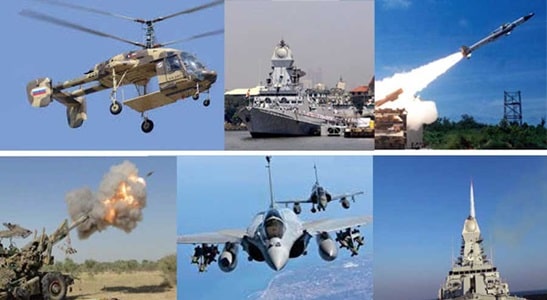Breaking Barriers: India’s Defence Exports Reach New Heights
India’s defence exports have achieved a remarkable, surpassing the ₹21,000-crore mark for the first time in history, signalling a significant leap of 32.5% in the fiscal year 2023-24. This substantial growth underscores India’s steadfast commitment to bolstering its indigenous defence manufacturing ecosystem and expanding its military exports, as the Ministry of Defence highlighted on Monday.

The ministry revealed that defence exports have surged to a record ₹21,083 crore (approximately US$ 2.63 billion), representing a remarkable increase from ₹15,920 crore in the previous fiscal year. This surge indicates a staggering 31-fold growth in defence exports over the past decade, compared to the fiscal year 2013-14.
Contributing to this impressive growth, both the private sector and the Defence Public Sector Undertakings (DPSUs) played pivotal roles, accounting for approximately 60% and 40% of exports, respectively. The number of export authorizations also witnessed an uptick from 1,414 in the fiscal year 2022-23 to 1,507 in the fiscal year 2023-24.
“Exciting news, everyone! I’m thrilled to share that India’s defence exports have achieved something truly remarkable. For the first time in the history of Independent India, our defence exports have crossed the monumental ₹21,000 crore mark. In the financial year 2023-24, we’ve reached an impressive ₹21,083 crore, showcasing an outstanding growth rate of 32.5% compared to the previous fiscal year,” penned Defence Minister Rajnath Singh on X.
India has set an ambitious defence export target of ₹35,000 crore by 2024-25, underscoring the country’s commitment to further boosting its military hardware exports. Presently, India exports military equipment to approximately 85 countries, with over 100 firms actively involved in this endeavour. The range of exported products includes missiles, artillery guns, rockets, armoured vehicles, offshore patrol vessels, personal protective gear, various radars, surveillance systems, and ammunition.
Comparative data spanning the periods from 2004-05 to 2013-14 and 2014-15 to 2023-24 reveals a remarkable surge in defence exports, growing 21 times over the years. Total defence exports during the period from 2004-05 to 2013-14 amounted to ₹4,312 crore, escalating to ₹88,319 crore in the subsequent period from 2014-15 to 2023-24.
Thanks to the visionary leadership of Prime Minister Narendra Modi, the Defence Ministry has rolled out numerous initiatives aimed at energizing India’s defence manufacturing and exports. The impressive performance exhibited by India’s defence industries, which includes both the private sector and DPSUs, speaks volumes about the effectiveness of these endeavours. Concerted efforts and strategic planning are driving our nation towards self-reliance and excellence in the realm of defence.
Military exports have experienced a significant upsurge, while imports have seen a decline, owing to policy interventions and reforms implemented over the past nine to ten years, as per government reports.
In a noteworthy announcement last May, the government revealed that the value of defence production in the country had surpassed the ₹1 lakh crore mark for the first time, propelled by key reforms aimed at catalyzing sectoral growth. The figures stood at ₹1,06,800 crore in FY 2022-23, compared to ₹95,000 crore in FY 2021-22 and ₹54,951 crore five years prior. The precise value of defence production in FY 2023-24 is yet to be disclosed.
India boasts a diverse array of weapons and systems, including the Tejas light combat aircraft (LCA), various types of helicopters, warships, tanks, artillery guns, missiles, rockets, military vehicles, and ammunition.
Over the last five to six years, India has intensified its focus on the defence manufacturing sector, undertaking numerous measures to attain self-reliance. These initiatives include prohibiting importing a range of weapons, systems, and parts, allocating a dedicated budget for procuring locally manufactured military hardware, elevating foreign direct investment from 49% to 74%, and enhancing the ease of doing business.

